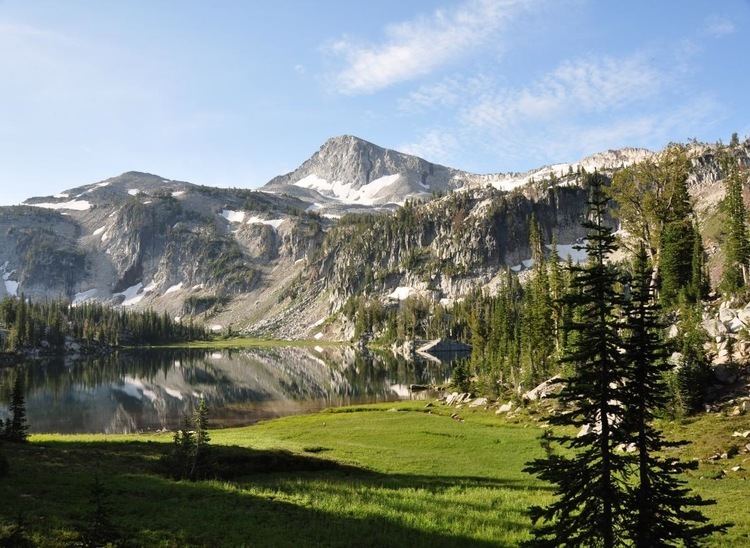Phone +1 541-523-6391 | Governing body U.S. Forest Service Area 1,463 km² Established 1940 | |
 | ||
Management United States Forest Service | ||
A hiker s journal eagle cap wilderness
Eagle Cap Wilderness is a wilderness area located in the Wallowa Mountains of northeastern Oregon (United States), within the Wallowa–Whitman National Forest. The wilderness was established in 1940. In 1964, it was included in the National Wilderness Preservation System. A boundary revision in 1972 added 73,000 acres (30,000 ha) and the Wilderness Act of 1984 added 66,100 acres (26,700 ha) resulting in a current total of 361,446 acres (146,272 ha; 565 sq mi), making Eagle Cap by far Oregon's largest wilderness area.
Contents
- A hiker s journal eagle cap wilderness
- Eagle cap wilderness oregon july 2016
- TopographyEdit
- HistoryEdit
- WildlifeEdit
- VegetationEdit
- RecreationEdit
- Wild and Scenic RiversEdit
- Lostine RiverEdit
- Eagle CreekEdit
- MinamEdit
- ImnahaEdit
- References
Eagle Cap Wilderness is named after a peak in the Wallowa Mountains, which were once called the Eagle Mountains. At 9,572 feet (2,918 m) Eagle Cap was incorrectly thought to be the highest peak in the range, hence the name.
Eagle cap wilderness oregon july 2016
TopographyEdit
The Eagle Cap Wilderness is characterized by high alpine lakes and meadows, bare granite peaks and ridges, and U-shaped glacial valleys. Thick timber is found in the lower valleys and scattered alpine timber on the upper slopes. Elevations in the wilderness range from approximately 3,000 feet (914 m) in lower valleys to 9,838 feet (2,999 m) at the summit of Sacajawea Peak with 30 other summits exceeding 8,000 feet (2,400 m). The wilderness is home to Legore Lake, the highest lake above sea level in Oregon at 8,950 feet (2,728 m), as well as almost 60 alpine lakes (9 of which are above 8,000 feet), and more than 37 miles (60 km) of streams.
HistoryEdit
The Eagle Cap Wilderness and surrounding country in the Wallowa–Whitman National Forest was first occupied by the ancestors of the Nez Perce Indian tribe around 1400 AD, and later by the Cayuse, the Shoshone, and Bannocks. The wilderness was used as hunting grounds for bighorn sheep and deer and to gather huckleberries. It was the summer home to the Joseph Band of the Nez Perce tribe. 1860 marked the year the first settlers moved into the Wallowa Valley. In 1930, the Eagle Cap was established as a primitive area and in 1940 earned wilderness designation.
WildlifeEdit
Eagle Cap Wilderness is home to a variety of wildlife, including black bears, cougars, Rocky Mountain bighorn sheep, and mountain goats. In the summer white-tailed deer, mule deer, and Rocky Mountain elk roam the wilderness. Smaller mammals that inhabit the area year-round include the pika, pine martens, badgers, squirrels, and marmots. Birds include peregrine falcons, bald eagles, golden eagles, ferruginous hawks, and gray-crowned rosy finch. Trout can be found in many of the lakes and streams in the wilderness. The Oregon State record golden trout was caught in the wilderness in 1987, by Douglas White. The lake where it was caught was not named.
Moose have recently returned to the wilderness; the herd now numbers about 40. There is possible evidence that grizzly bears and wolverines are returning as well.
VegetationEdit
Plant communities in the Eagle Cap Wilderness range from low elevation grasslands and ponderosa pine forest to alpine meadows. Engelmann spruce, larch, mountain hemlock, sub-alpine fir, and whitebark pine can be found in the higher elevations. Varieties of Indian paintbrush, sego lilies, elephanthead, larkspur, shooting star, and bluebells are abundant in the meadows. The wilderness does contain some small groves of old growth forest.
RecreationEdit
As Oregon's largest wilderness area, Eagle Cap offers many recreational activities, including hiking, backpacking, horseback riding, hunting, fishing, camping, and wildlife watching. Winter brings backcountry skiing and snowshoeing opportunities. There are 47 trailheads and approximately 534 miles (859 km) of trails in Eagle Cap, accessible from Wallowa, Union, and Baker Counties, and leading to all areas of the wilderness.
Wild and Scenic RiversEdit
Four designated Wild and Scenic Rivers originate in Eagle Cap Wilderness—the Lostine, Eagle Creek, Minam, and Imnaha.
Lostine RiverEdit
16 miles (26 km) of the Lostine from its headwaters in the wilderness to the Wallowa–Whitman National Forest boundary are designated Wild and Scenic. Established in 1988, 5 miles (8 km) of the river are designated "wild" and 11 miles (18 km) are designated "recreational." A small portion of the river is on private property.
Eagle CreekEdit
27 miles (43 km) of Eagle Creek from its output at Eagle Lake in the wilderness to the Wallowa–Whitman National Forest boundary at Skull Creek are designated Wild and Scenic. In 1988, 4 miles (6 km) of the river were designated "wild," 6 miles (10 km) are designated "scenic," and 17 miles (27 km) are designated "recreational."
MinamEdit
39 miles (63 km) of the Minam River from its headwaters at the south end of Minam Lake to the wilderness boundary, one-half mile downstream from Cougar Creek, are designated Wild and Scenic. In 1988, all 39 miles (63 km) were designated "wild."
ImnahaEdit
77 miles (124 km) of the Imnaha River from its headwaters are designated Wild and Scenic. The designation comprises the main stem from the confluence of the North and South Forks of the Imnaha River to its mouth, and the South Fork from its headwaters to the confluence with the main stem. In 1988, 15 miles (24 km) miles were designated "wild," 4 miles (6 km) were designated "scenic," and 58 miles (93 km) were designated "recreational," though only a portion of the Wild and Scenic Imnaha is located within Eagle Cap Wilderness.
